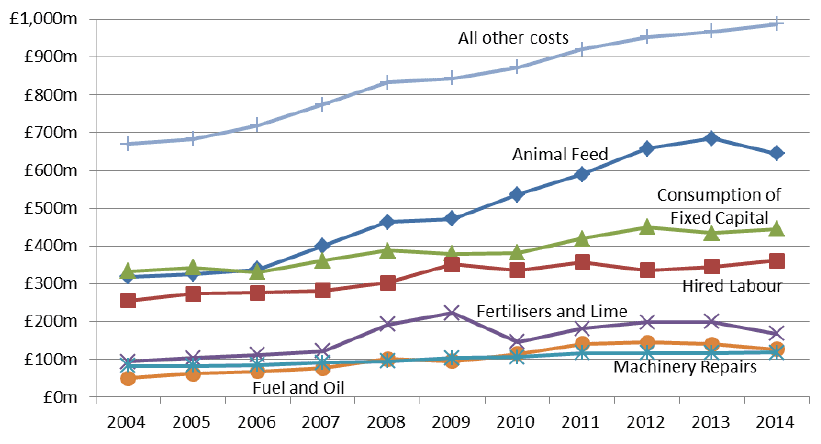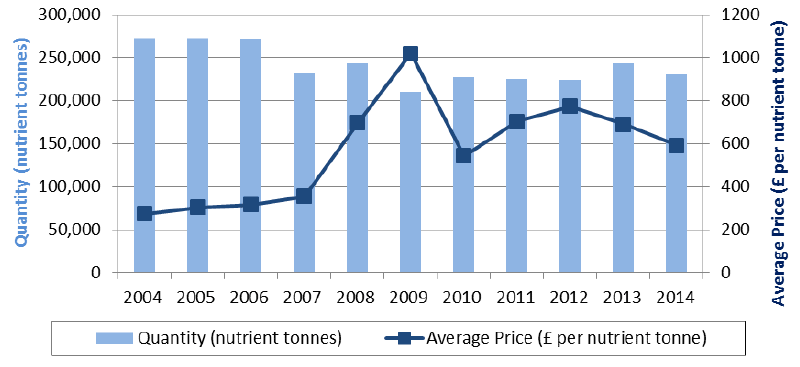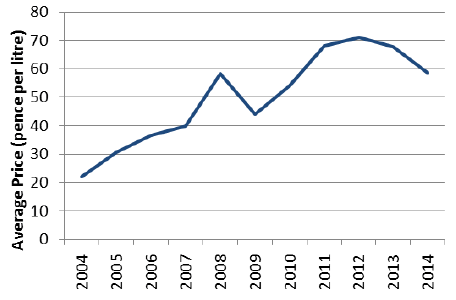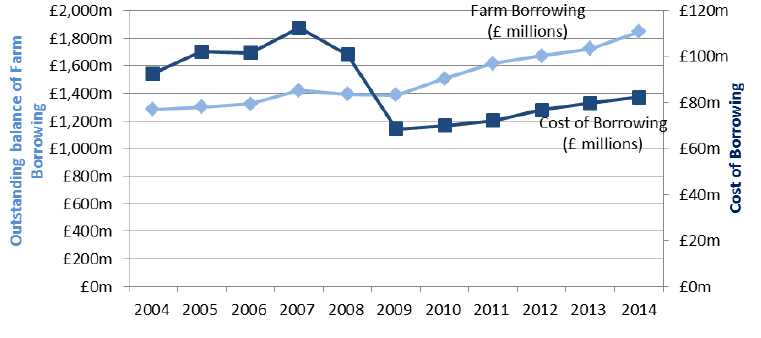Economic Report on Scottish Agriculture 2015
Economic Report on Scottish Agriculture 2015 presenting an overall picture of Scottish agriculture using data from the various agricultural surveys that RESAS manage.
3.13 Farming costs (Table A1)
In 2014, the initial TIFF estimate for the total costs incurred by agricultural businesses was £2.85 billion. These costs are made up of many different components. Estimates for 2014 are very dependent upon data not available until later in 2015, and so those presented here should only be considered provisional.
Please note that in this section (3.13 to 3.13.5), increases are stated in actual terms, rather than real terms. For calculations of real terms increases, inflation since 2004 was 26.7 per cent and since 2013 was 2.0 per cent.
In 2014, the largest costs were for: animal feed (£644 million or 23 per cent of the total); consumption of fixed capital (£445 million or 16 per cent, including £181 million of livestock); hired labour (£361 million or 13 per cent); fertilisers and lime (£169 million or six per cent); fuel and oil (£127 million or four per cent) and machinery repairs (£119 million or four per cent). All other costs, totalling £987 million accounted for 35 per cent of the total.
Chart 3.19: Total farming costs 2004 to 2014

Since 2004, total costs have increased by £1,046 million (58 per cent) from £1.8 billion to £2.9 billion in 2014. The largest increases have occurred in animal feed (up £325 million or 102 per cent) and fuel and oil (up £76 million or 150 per cent).
3.13.1 Animal feed (Tables A1, A7)
Most of the animal feed costs are associated with the purchase of concentrate feed, especially for cattle and sheep. Over the past ten years, increasing trends in the cost of these concentrate feeds have contributed the most to the overall increase in animal feed costs; however, they saw an estimated six per cent fall in 2014.
3.13.2 Fertiliser and lime (Tables A1, A8)
There has been substantial variation in the cost of fertilisers and lime over the past few years, as shown in Chart 3.20. Table A8 shows key components of the underlying price and quantity information used in the compilation of the fertiliser and lime valuation.
It should be noted that the vast majority of fertilisers are used in the first half of the calendar year. However, a substantial proportion of these fertilisers will have been purchased in the previous autumn/winter. This lag between purchases and usage has been accounted for in the TIFF valuation and should be borne in mind when comparing average annual prices in TIFF with monthly market prices.
Chart 3.20 shows a summary of fertiliser usage and average annual prices, expressed in terms of nutrient tonnes. Nutrient tonnes are used in order to account for different types of fertilisers which have different compositions in terms of nutrient content.
Chart 3.20: Quantity and average annual prices of fertilisers used 2004 to 2014

There was a decreasing trend in the usage of fertilisers between 2004 and 2010, with the volume remaining fairly steady since then. Compared to 2004, the quantity of fertiliser usage in 2014 was 41,700 tonnes lower (15 per cent), however the average price was £319 per tonne higher (117 per cent). Over this period average prices increased sharply from 2007 to a peak of £1,021 per tonne in 2009. In 2010, prices fell back before rising again in 2011 and 2012, and then falling back. Prices were estimated to have fallen 14 per cent in 2014, accounting for the small decrease estimated in the total cost of fertilisers and lime.
3.13.3 Hired labour (Tables A1, A10)
Hired labour costs increased by £106 million (41 per cent) between 2004 and 2014. These costs are calculated by taking into account the number of hired workers reported in the June Agricultural Census and information on earnings from the monthly Survey of Hours and Earnings of Agricultural Workers.
Between 2003 and 2009 there was a gradual decline in the number of hired regular workers, which has steadied in recent years. The number of casual and seasonal workers has been increasing, particularly since 2006.
3.13.4 Fuel (Tables A1, A9)
Red diesel is used as fuel by agricultural businesses. Red diesel is cheaper than conventional diesel, as it attracts lower rates of tax. The overall trend in red diesel
Chart 3.21: UK red diesel annual average prices 2004 to 2014

prices has shown a steady increase since 2003, with a spike in prices during 2008. Prices remained fairly stable between 2011 and 2013, however prices in 2014 have shown a decrease to a level similar to that in 2010.
In 2014, the estimated overall cost of fuel and oil decreased by £14 million (ten per cent), reflecting the nine pence per litre (13 per cent) decrease in red diesel prices.
3.13.5 Net interest payments (Tables A1, A11)
Over the past ten years there has been a steady increase in the balance of farm borrowing from banks and other institutions, from £1.3 billion in 2004 to £1.8 billion in 2014. Over the same period, the corresponding cost of borrowing has varied, reflecting changes in underlying interest rates.
There was a large fall in the cost of borrowing (split into two components in table A1, financial services and interest) between 2008 and 2009 of £32 million (32 per cent) due to a decrease in the base rate of interest. The situation has been more stable since 2009, with the small increase predicted between 2013 and 2014 of £2.6 million (three per cent) due to a rise in the estimated amount of borrowing from other sources, identified from the Farm Accounts Survey.
Chart 3.22: Outstanding balance of farm borrowing & cost of borrowing 2004 to 2014

Contact
Email: Agricultural Statistics
There is a problem
Thanks for your feedback